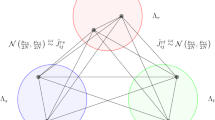Abstract
We provide the first examples of two-step replica symmetry breaking (2-RSB) models for the spherical mixed p-spin glass at zero temperature. Precisely, we show that for a certain class of mixtures, the Parisi measure at zero temperature is purely atomic and has exactly three distinct points in its support. We then derive a few consequences for the topology of the random landscape in these cases. Our main result also provides a negative answer to a question raised in 2011 by Auffinger and Ben Arous about the classification of pure-like and full mixture models.
Similar content being viewed by others
References
Auffinger A., Ben Arous G.: Complexity of random smooth functions on the high-dimensional sphere Ann. Probab. 41(6), 4214–4247 (2013)
Auffinger A., Ben Arous G., Černý J.: Random matrices and complexity of spin glasses. Commun. Pure Appl. Math. 66(2), 165–201 (2013)
Auffinger A., Chen W.K.: On properties of Parisi measures. Probab. Theory Relat. Fields 161(3-4), 817–850 (2015)
Auffinger A., Chen W.K.: The Parisi formula has a unique minimizer. Commun. Math. Phys. 335(3), 1429–1444 (2015)
Auffinger A., Chen W.K.: On the energy landscape of spherical spin glasses. Adv. Math. 330, 553–588 (2018) arXiv preprint arXiv:1702.08906 (2017)
Auffinger, A., Chen, W.K., Zeng, Q.: The SK model is full-step replica symmetry breaking at zero temperature. arXiv preprint arXiv:1703.06872 (2017)
Bolthausen, E.: Random media and spin glasses: an introduction into some mathematical results and problems. In: Spin Glasses, Lecture Notes in Mathematics, vol. 1900, pp. 1–44. Springer, Berlin (2007)
Bovier, A., Kurkova, I.: Much ado about Derrida’s GREM. In: Spin Glasses, Lecture Notes in Mathematics, vol. 1900, pp. 81–115. Springer, Berlin (2007)
Chen W.K., Sen A.: Parisi formula, disorder chaos and fluctuation for the ground state energy in the spherical mixed p-spin models. Commun. Math. Phys. 350(1), 129–173 (2017)
Crisanti A., Leuzzi L.: Spherical 2+ p spin-glass model: an exactly solvable model for glass to spin-glass transition. Phys. Rev. Lett. 93, 217–203 (2004)
Crisanti A., Leuzzi L.: Amorphous–amorphous transition and the two-step replica symmetry breaking phase. Phys. Rev. B 76, 184–417 (2007)
Crisanti A., Leuzzi L.: Reply to “comment on ‘spherical 2+ p spin-glass model: an analytically solvable model with a glass-to-glass transition’ ”. Phys. Rev. B 76, 136–402 (2007)
Crisanti A., Sommers H.J.: The spherical p-spin interaction spin glass model: the statics. Zeitschrift für Physik B Condensed Matter 87(3), 341–354 (1992)
Derrida B.: Random-energy model: an exactly solvable model of disordered systems. Phys. Rev. B (3) 24(5), 2613–2626 (1981)
Jagannath A., Tobasco I.: Low temperature asymptotics of spherical mean field spin glasses. Commun. Math. Phys. 352, 979–1017 (2017) arXiv preprint arXiv:1602.00657
Kosterlitz J.M., Thouless D.J., Jones R.C.: Spherical model of a spin-glass. Phys. Rev. Lett. 36, 1217–1220 (1976)
Krakoviack V.: Comment on “spherical 2 + p spin-glass model: an analytically solvable model with a glass-to-glass transition”. Phys. Rev. B 76, 136–401 (2007)
Mézard M., Parisi G., Virasoro M.A.: Spin glass theory and beyond, World Scientific Lecture Notes in Physics, vol. 9. World Scientific Publishing Co., Inc., Teaneck, NJ (1987)
Panchenko D.: The Sherrington–Kirkpatrick Model, Springer Monographs in Mathematics. Springer, Berlin (2013)
Panchenko D., Talagrand M.: On the overlap in the multiple spherical SK models. Ann. Probab. 35(6), 2321–2355 (2007)
Talagrand M.: Free energy of the spherical mean field model. Probab. Theory Relat. Fields 134(3), 339–382 (2006)
Acknowledgment
We would like to thank Wei-Kuo Chen for helpful discussions in the initial stage of this project. We also thank the referees for many suggestions, which have helped to improve the presentation of the paper.
Author information
Authors and Affiliations
Corresponding author
Additional information
Communicated by H. Spohn
Antonio Auffinger: Research partially supported by NSF Grant CAREER DMS-1653552 and NSF Grant DMS-1517894.
Rights and permissions
About this article
Cite this article
Auffinger, A., Zeng, Q. Existence of Two-Step Replica Symmetry Breaking for the Spherical Mixed p-Spin Glass at Zero Temperature. Commun. Math. Phys. 370, 377–402 (2019). https://doi.org/10.1007/s00220-018-3252-3
Received:
Accepted:
Published:
Issue Date:
DOI: https://doi.org/10.1007/s00220-018-3252-3




